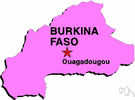
In 1980, he became the aide-de-camp to the Chief of Staff of the Army. In May 1978, he was assigned to the Airborne Response Company of Bobo-Dioulasso (83). A 56 days’ strike of the SNEAHV deteriorated the social climate and paralyzed the Third Republic (82).Ĭompaoré’s political engagement with Marxism was consolidated during the Third Republic. Forming an active minority in secondary schools and universities, the extreme left produced many political parties and powerful teachers’ trade unions like the SUVESS ( Syndicat Unique Voltaïque de l’Enseignement Sécondaire et Supérieur) and the SNEAHV ( Syndicat National des Enseignants Africains de Haute-Volta). The communist party “ Parti Africain de l’Indépendance de Haute-Volta” was founded in 1963 (81). The permanent instability eventually benefited the extreme left, which had witnessed many years of Upper Volta’s political life (80). And, on November 30, 1977, a new Constitution was adopted, giving birth to the Third Republic (79). On February 9, 1976, a transitional government was formed. Unions, political parties, religious leaders and similar organized general strike days, forcing president Lamizana to accept a return to a republican regime. Encouraged by a growing popular mobilization to defend the frontiers against the Malian « invasion », eventually escalating in a 3-day’s war between both countries, the army started to feel again and did not resist any longer the temptation to create on November 29,1975, the “only and unique” party le “ Mouvement National pour le Renouveau” (MNR). Politically, it was also a tense period in Ouagadougou. In this period, the world witnessed escalations of the Cold War in Third World countries: the Vietnam War, military coups in Chile, Uruguay and Argentina, as well as the Yom Kippur War and the Ogaden War in Africa. Outraged by social misery, rampant famines (78) and inadequate government programs in response to these challenges, Compaoré drew inspiration from communism. Twice in 1982, Captain Blaise Compaoré received special training as a paratrooper commander in Pau (France) the courses included free-falling techniques from an altitude of 3,000 meters and the strategic and logistic combat planning of 500 parachutists (77). Several military trainings far from home followed: specialization at the Infantry School of Montpellier, commando instructor courses in Mont-Louis, Collioure, Briançon and in Montgenèvre (all in France) as well as in Münsingen (Germany), followed by training at the French airborne and instructor courses for paratroopers in Rabat (Morocco) in 1978 (76). In September 1973, he passed the entrance examination of the Inter-Army Military Academy of Cameroon (75). On February 8, President Lamizana dissolved the National Assembly and the Government, and remilitarized the institutions (74).Īt that time, Compaoré was abroad. On February 2, 1974, the trade unions asked the Head of State Sangoulé Lamizana “ to end the untenable situation as soon as possible” (73).

1973-1976, Military training abroadĭuring the Second Republic, the pending presidential elections of 1975 brought about a political deadlock. Very soon, Compaoré was appointed to guard the home of Sangoulé Lamizana, the Head of State of Burkina Faso (72). What was meant as a correction turned out to be a blessing for the young man who had always dreamed of becoming a soldier like his father. In 1971, after a student demonstration, Compaoré “ l’enfant terrible de Ziniaré” was enrolled by force in the special contingent of the Army as a punishment.

During this brief but intense period of fertile political life in Burkina, the young Blaise attended l’Ecole Normale de Ouagadougou (E.N.O.) in the capital where he led student rights movements on several occasions. In December 1970, several political parties participated in the country’s first real legislative elections (70). The army Chief of Staff Sangoulé Lamizana, supported by the Roman Catholic Church, took over from him in a bloodless coup, establishing a military regime (69). He was overthrown by street demonstrators on January 3, 1966. The authoritarian regime of the first President of the Republic Maurice Yaméogo provoked a national revolt. 1982 : special elite training in commanding paratroopers in Pau (France)ġ970-1980, military career and political awakening.1980, November 25 : 3rd putsch by Colonel Saye Zerbo.1977, November 30 : birth of the 3rd Republic.1974, February 8 : 2nd putsch by President Sangoulé Lamizana.Burkina heading international organisations.


 0 kommentar(er)
0 kommentar(er)
